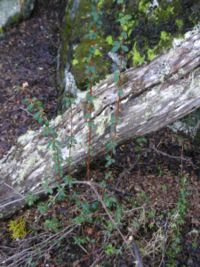Berberis buxifolia
| Berberis buxifolia subsp. var. | ||||||||||||||||||||||||||||||||||||||||||||||||||||||||
|---|---|---|---|---|---|---|---|---|---|---|---|---|---|---|---|---|---|---|---|---|---|---|---|---|---|---|---|---|---|---|---|---|---|---|---|---|---|---|---|---|---|---|---|---|---|---|---|---|---|---|---|---|---|---|---|---|

|
|
| ||||||||||||||||||||||||||||||||||||||||||||||||||||||
| ||||||||||||||||||||||||||||||||||||||||||||||||||||||||
| Standard Cyclopedia of Horticulture |
|---|
|
Berberis buxifolia, Poir. (B. dulcís, Sweet). One to 3 ft.: branches brown, grooved; spines usually 3-parted, short: Lvs. cuneate, obovate or elliptic, ⅓-1 in. long: fls. solitary, on long pedicels, orange-yellow: fr. nearly globose, blackish purple. May. Chile to Strait of Magellan. B.M. 6505. S.B.F.G. II. 1:100. P.M. 10:171. L.B.C.20:1941. H.F. 1857:122.—A very graceful, free-flowering shrub; one of the hardiest of the evergreen species; will stand the winter even N. if somewhat protected.
|
| Berberis buxifolia {{{status}}} Fossil range: {{{fossil_range}}}
| ||||||||||||||||||||||||||||||||||||||||||||||||||||||||||||||||||
|---|---|---|---|---|---|---|---|---|---|---|---|---|---|---|---|---|---|---|---|---|---|---|---|---|---|---|---|---|---|---|---|---|---|---|---|---|---|---|---|---|---|---|---|---|---|---|---|---|---|---|---|---|---|---|---|---|---|---|---|---|---|---|---|---|---|---|
 | ||||||||||||||||||||||||||||||||||||||||||||||||||||||||||||||||||
| Plant Info | ||||||||||||||||||||||||||||||||||||||||||||||||||||||||||||||||||
| ||||||||||||||||||||||||||||||||||||||||||||||||||||||||||||||||||
| Scientific classification | ||||||||||||||||||||||||||||||||||||||||||||||||||||||||||||||||||
| ||||||||||||||||||||||||||||||||||||||||||||||||||||||||||||||||||
| [[{{{diversity_link}}}|Diversity]] | ||||||||||||||||||||||||||||||||||||||||||||||||||||||||||||||||||
| {{{diversity}}} | ||||||||||||||||||||||||||||||||||||||||||||||||||||||||||||||||||
| Binomial name | ||||||||||||||||||||||||||||||||||||||||||||||||||||||||||||||||||
| Berberis buxifolia Lam. | ||||||||||||||||||||||||||||||||||||||||||||||||||||||||||||||||||
| Trinomial name | ||||||||||||||||||||||||||||||||||||||||||||||||||||||||||||||||||
| {{{trinomial}}} | ||||||||||||||||||||||||||||||||||||||||||||||||||||||||||||||||||
| Type Species | ||||||||||||||||||||||||||||||||||||||||||||||||||||||||||||||||||
| {{{type_species}}} | ||||||||||||||||||||||||||||||||||||||||||||||||||||||||||||||||||
| {{{subdivision_ranks}}} | ||||||||||||||||||||||||||||||||||||||||||||||||||||||||||||||||||
| [[Image:{{{range_map}}}|{{{range_map_width}}}|]] | ||||||||||||||||||||||||||||||||||||||||||||||||||||||||||||||||||
| Synonyms | ||||||||||||||||||||||||||||||||||||||||||||||||||||||||||||||||||
| {{{synonyms}}} |
- Calafate redirects here. For the Patagonian town, see El Calafate
Berberis buxifolia, common name the Magellan Barberry, in Spanish Calafate, is an evergreen shrub, with shiny box-like leaves. The Calafate is native to the south of Argentina and Chile and is a symbol of Patagonia.
The bush grows to a height of 1 - 1.5 m. It has many arching branches, each covered in many tripartite spines. The bush has many small yellow flowers in summer. Its edible blue-black berries are harvested for jams, but are eaten fresh too - a legend tells that anyone who eats a Calafate berry will be certain to return to Patagonia.
The Calafate is grown commercially for its fruit, potential medical uses and as a garden plant or bonsai. Its wood is used to make a red dye. The cultivar Berberis buxifolia 'Nana' is widely available as a garden shrub, and is also used in commercial plantings as a low spiny hedge to discourage intruders, but it does not fruit.
de:Buchsblättrige Berberitze es:Berberis microphylla fr:Berbéris à feuilles de buis it:Berberis buxifolia